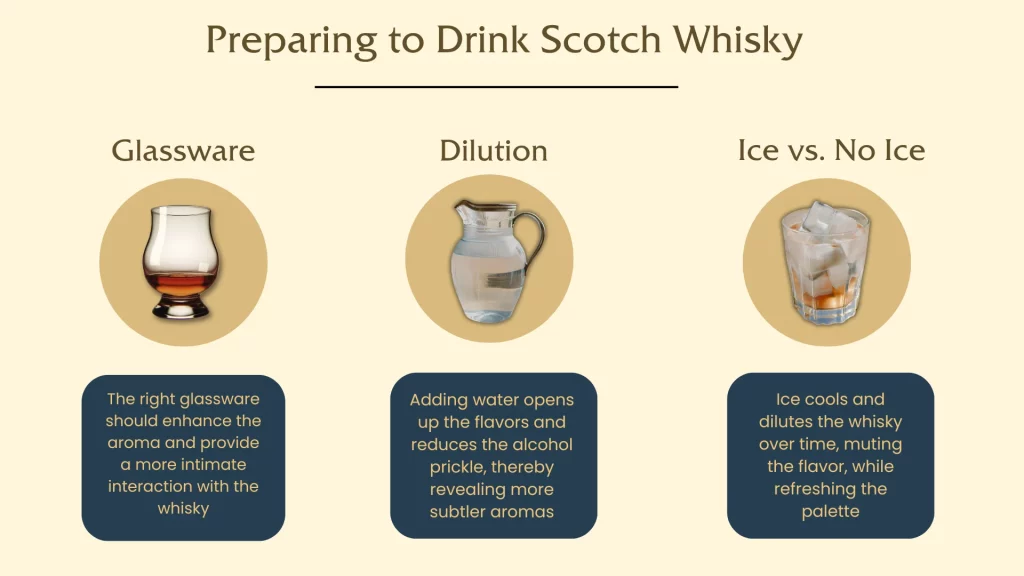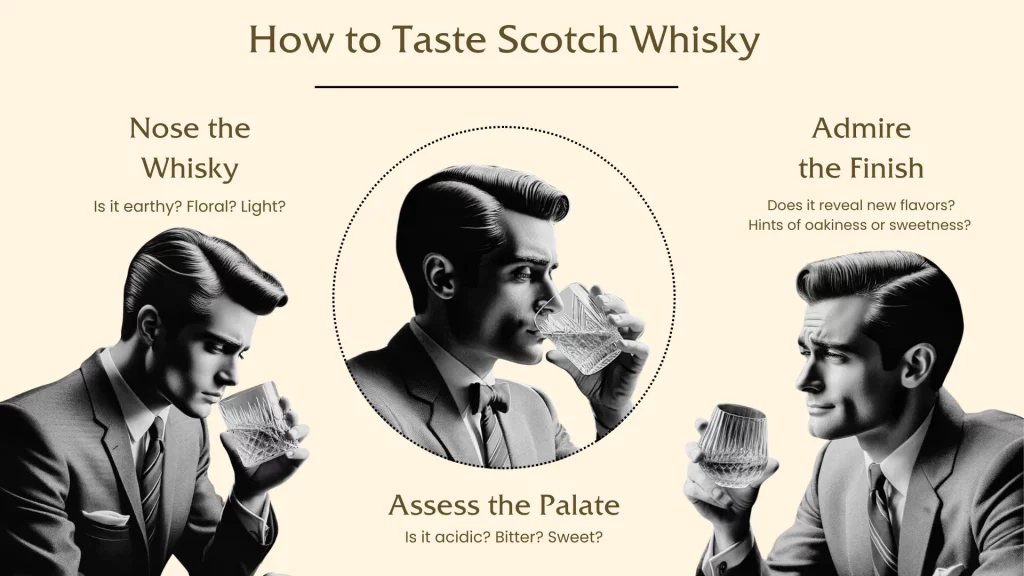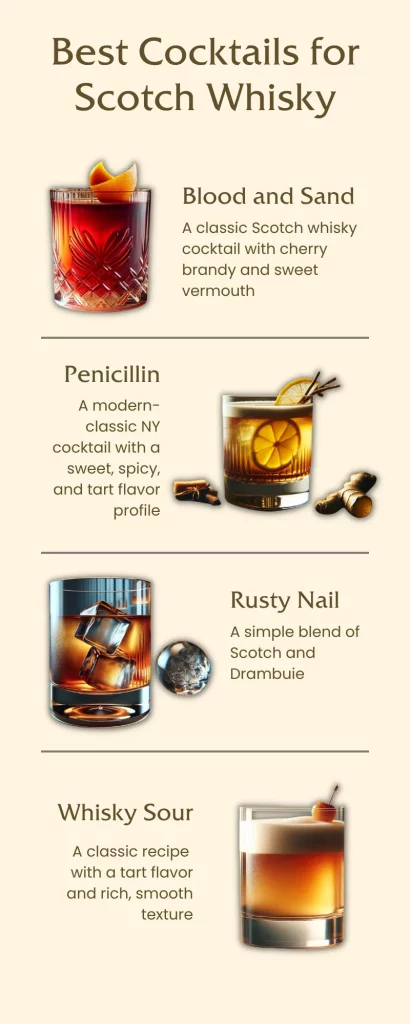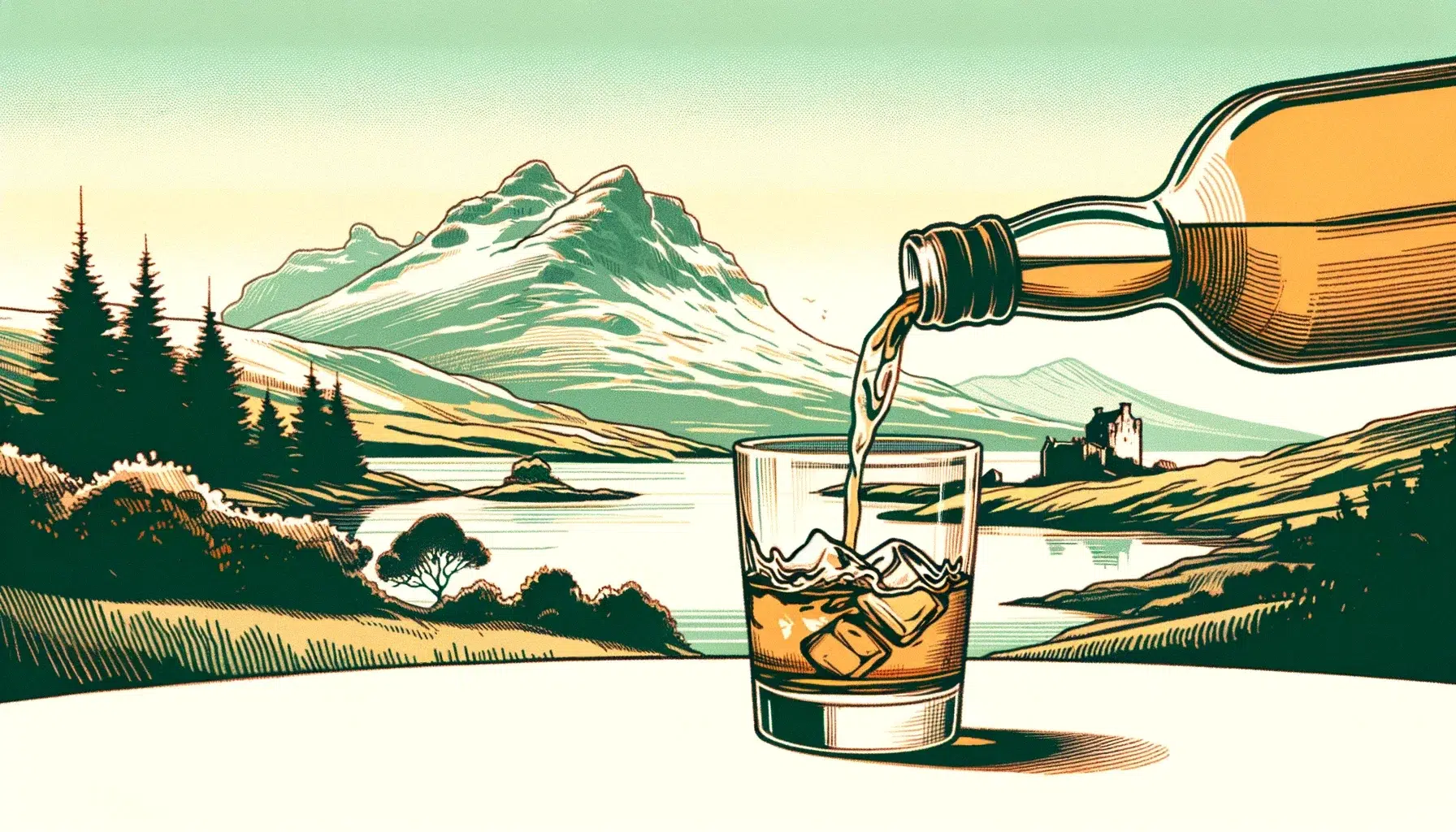Scotch whisky, the original heavyweight of the whisky world, brings a taste of the Scottish homeland to every glass. To get the most out of its range, from Single Malt to Blended Whiskies, knowing how to drink it is crucial.
We’re going to walk you through how to properly enjoy Scotch whisky, touching on choosing the right whisky, the best glasses to use, and how to taste it like a pro. Dive into the craftsmanship and stories behind each bottle, and let’s raise a glass to Scotland’s finest.
What is Scotch Whisky
Scotch whisky is a distilled spirit crafted exclusively in Scotland. It’s revered for its unparalleled quality and diversity. To bear the name “Scotch,” the whisky must adhere to rigorous production criteria set by Scottish law, including distillation and aging in oak barrels within Scotland for a minimum of three years. This meticulous process ensures that each bottle of Scotch whisky encapsulates the essence of its Scottish heritage, from the water source to the peat used in malting.
The variations within Scotch whisky—Single Malt, Single Grain, Blended Malt, Blended Grain, and Blended Scotch Whisky—offer a spectrum of flavors and aromas, shaped by the distinct characteristics of Scotland’s whisky-producing regions. These regions, each with its unique terroir, contribute to the whisky’s flavor profile, from the peaty, smoky whiskies of Islay to the light and floral notes of the Lowlands. Understanding Scotch whisky involves appreciating its rich history, the artistry behind its production, and the intricate flavors that make it a celebrated spirit worldwide.
Choosing the Right Scotch
Selecting the best Scotch whisky is an art that balances personal taste with an understanding of the spirit’s diverse landscape. The journey to finding the right Scotch begins with considering accolades, which can guide newcomers towards highly regarded expressions. However, the age of a Scotch, often seen as a marker of quality and complexity, plays a crucial role in its character, with older whiskies offering deeper, more nuanced flavors.
Yet, the age statement is not the sole determinant of excellence. The flavor profile of a Scotch—ranging from rich and peaty to smooth and fruity—is perhaps the most critical factor in selection, as it aligns with individual preferences and occasions for drinking. Whether you’re drawn to the smoky intensity of an Islay malt or the gentle elegance of a Speyside blend, understanding these key elements can lead to a more informed and satisfying choice.

By Accolades
Choosing a Scotch whisky based on accolades involves looking at awards and recognitions from reputable spirits competitions. These accolades can serve as a benchmark for quality, offering assurance that the whisky has been judged favorably by industry experts. While accolades should not be the sole criterion, they provide a useful starting point for those new to Scotch or looking to explore highly esteemed expressions.
By Age
The age of a Scotch whisky is a key indicator of its character and complexity. Generally, the longer a whisky matures in oak barrels, the more depth and nuance it acquires. Age statements on bottles reveal the minimum time the whisky has spent aging, guiding enthusiasts towards expressions that match their preference for either youthful vibrancy or mature richness.
However, it’s important to remember that age is just one aspect of a whisky’s profile, and not all older whiskies may suit every palate.
If you want a deeper look on how age effects a whisky’s value, check out our article on whiskey collecting.
By Flavor Profile
The flavor profile of a Scotch whisky is the most direct route to personal satisfaction. Scotch whiskies present a wide array of flavors, from the smoky and peaty notes characteristic of Islay malts to the smooth and sweet profiles found in Highland and Speyside regions. Understanding your own flavor preferences—whether you lean towards bold and intense or light and delicate—is crucial in selecting a Scotch that you’ll truly enjoy.
Tasting different Scotch whiskies and noting their flavor profiles can help refine your palate and lead you to your ideal dram.
Preparing to Drink Scotch Whisky
The experience of drinking Scotch whisky begins long before the first sip. Preparing to drink Scotch involves a few key considerations that can significantly enhance the tasting experience. Glassware plays a pivotal role, with the shape of the glass affecting the whisky’s aroma and taste.
A tulip-shaped glass, for example, concentrates the whisky’s aromatics, offering a richer olfactory experience. Dilution is another important factor; adding a few drops of water can unlock new flavors and aromas in the whisky, making the tasting experience more complex. Finally, the decision of ice or no ice depends on personal preference, but it’s worth noting that while ice can cool and dilute the whisky, potentially making it more refreshing, it may also mask some of the subtler flavors.
Each of these elements—glassware, dilution, and ice—contributes to the overall enjoyment and appreciation of Scotch whisky.

Glassware
Selecting the right glassware is crucial for maximizing the Scotch whisky experience. A tulip-shaped glass, often recommended, is designed to concentrate the aromas at the narrow opening, enhancing the olfactory pleasure and, consequently, the taste. This type of glass allows for a more intimate interaction with the whisky, making it the preferred choice for tastings and savoring premium Scotches.
Dilution
Dilution with water can be a contentious topic among whisky enthusiasts, but it serves a purpose. Adding a few drops of water to Scotch whisky can reduce the alcohol strength, which may otherwise overpower the subtle flavors and aromas. This slight dilution can unveil hidden notes and complexities, offering a more rounded and enjoyable tasting experience.
The key is moderation, ensuring that the whisky’s character is refined, not diluted.
Ice or No Ice
The debate of ice or no ice in Scotch whisky is a matter of personal preference, influenced by the desire for purity versus refreshment. Ice chills the whisky, which can be refreshing but may also mute some of its flavors and aromas. On the other hand, drinking Scotch neat, at room temperature, allows all the nuances of the whisky to shine through.
For those who prefer their whisky chilled without dilution, whisky stones are an alternative, cooling the drink without adding water.
How To Properly Taste Scotch Whisky
If you want a more comprehensive overview on how to properly taste any kind of whiskey, check out our article on the whiskey tasting process.
Tasting Scotch whisky is an art that involves engaging all the senses to fully appreciate the spirit’s complexity. It begins with nosing the whisky, where the aroma is carefully inhaled to identify the range of scents, from peaty smokiness to floral sweetness, that Scotch whisky can exhibit. This is followed by assessing the palate, where the whisky is sipped and allowed to coat the mouth, revealing the layers of flavors, such as vanilla, oak, fruit, or spice, that define its character.
The experience culminates in admiring the finish, the lasting impression of the whisky after swallowing, which can range from short and sweet to a prolonged, evolving sensation. Each step in this process contributes to a deeper understanding and enjoyment of Scotch whisky, highlighting the subtleties that make each bottle unique.

Nosing The Whisky
Nosing the whisky is the first step in the tasting process, where the aroma is explored. By gently swirling the glass and taking a careful sniff, you can uncover a multitude of scents. This act allows the whisky to release its full bouquet, revealing everything from the deep, earthy notes of peat to the light, airy hints of citrus and floral.
It’s a crucial stage that sets the stage for flavor anticipation, engaging the sense of smell to predict the complex tastes that follow.
Assessing The Palate
Assessing the palate involves taking a small sip of the whisky and letting it spread across your tongue. This moment is where the whisky’s flavor profile comes alive, showcasing its balance between sweetness, acidity, bitterness, and umami. Here, the whisky’s character is fully savored, from the initial taste to the way it evolves in the mouth.
Notes of caramel, oak, spice, or fruit may emerge, offering a direct connection to the whisky’s aging process and ingredient composition.
Admiring The Finish
Admiring the finish refers to the sensations and flavors that linger after the whisky has been swallowed. This final phase of tasting can vary greatly, from a short, crisp end to a long, evolving aftertaste that changes over time. The finish can reveal new flavors not detected in the nose or palate, such as a smoky undertone or a hint of sweetness, providing a lasting memory of the whisky’s complexity and craftsmanship.
Best Cocktails For Scotch Whisky
While Scotch whisky is often enjoyed neat or with a splash of water, its rich and complex flavors also make it a superb base for a variety of Scotch cocktails. From classic concoctions to modern mixology marvels, Scotch whisky lends itself to a variety of cocktail recipes that highlight its depth and versatility. Blood and Sand, Penicillin, and Rusty Nail are among the most iconic Scotch whisky cocktails.
Each of these drinks showcases Scotch whisky in a different light, blending it with complementary ingredients to create a harmonious and intriguing drinking experience. Whether you prefer the smoky notes of an Islay malt or the smoothness of a Highland blend, there’s a Scotch whisky cocktail that will suit your taste, offering a delightful twist on the traditional whisky experience.

Blood and Sand
The Blood and Sand cocktail is a classic choice for Scotch whisky enthusiasts. Named after Rudolph Valentino’s 1922 bullfighter movie, this cocktail combines Scotch whisky with cherry brandy, sweet vermouth, and orange juice. The result is a beautifully balanced drink with a sweet, complex flavor profile that complements the whisky’s depth.
It’s a testament to the versatility of Scotch, proving it can play well with a range of flavors.
Penicillin
Penicillin is a modern classic that showcases Scotch whisky in a refreshing, medicinal-themed concoction. Created by mixologist Sam Ross, this cocktail combines blended Scotch whisky with the smoky notes of an Islay single malt, fresh lemon juice, and a honey-ginger syrup. The Penicillin offers a perfect balance of sweet, sour, spicy, and smoky flavors, making it an invigorating choice for those looking to explore the nuanced side of Scotch whisky cocktails.
Rusty Nail
The Rusty Nail stands as a testament to the simplicity and elegance of Scotch whisky cocktails. This drink is a straightforward mix of Scotch whisky and Drambuie, a Scotch whisky liqueur infused with honey, herbs, and spices. The Rusty Nail is served on the rocks, allowing the warmth of the whisky to meld seamlessly with the sweet and herbal notes of Drambuie.
This cocktail’s enduring popularity is a tribute to its smooth, rich flavor and the effortless harmony between its two key ingredients.





